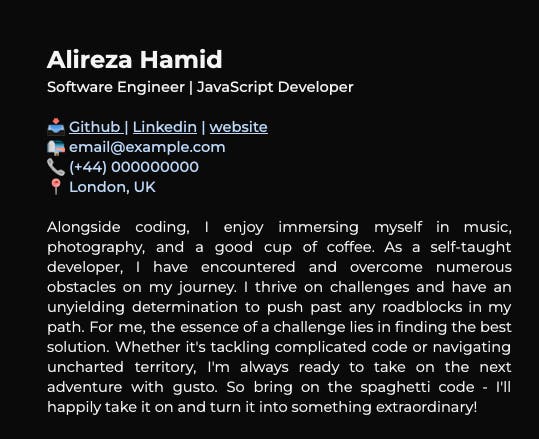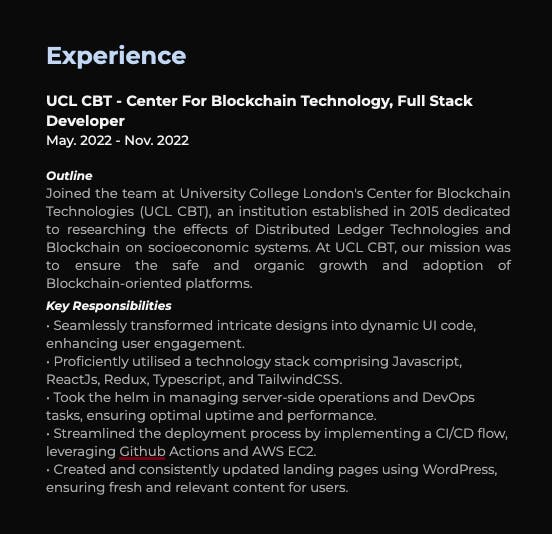Table of contents
- Getting Started: What You’ll Need and What to Expect:
- Core Design Tenets: Streamlining Your Resume’s Aesthetics:
- Instruction to Write an Eye-Catching ‘About Me’
- Crafting an Effective ‘Skills’ Section
- Crafting a Stellar Experience Section
- Crafting an Impressive ‘Awards’ Section
- Crafting an Effective ‘Education’ Section
- Crafting the ‘Interests’ Section
- Conclusion
You only get one shot at a first impression, and in the job-hunting realm, that’s your resume. We’ve all faced the dreaded blank screen, wishing for a magic wand to craft that masterpiece. But who needs magic when you’ve got a strategy? Imagine if resumes were first dates — many would be the cringe-worthy kind where mismatched socks make an appearance. But here’s your golden ticket: a guide to ensure your resume isn’t just presentable, but royally impressive. Dive in, and let’s transform that job application game!
Getting Started: What You’ll Need and What to Expect:
- A high supply of good Mood :)
- A free time to spend
- Google document
Before we dive in, I’d like to share a snippet of my journey. Every insight in this guide has been meticulously pieced together from countless hours of research, course attendance, invaluable workshops, candid chats with seasoned recruiters, and most importantly, firsthand experience in the trenches of job hunting. What you’ll find here is a distilled essence of wisdom — those golden nuggets often reserved for those who’ve trodden the path for a considerable time. I’ve done the legwork so you won’t have to.
Core Design Tenets: Streamlining Your Resume’s Aesthetics:
- Brevity is Key: Limit your resume to one page. You’re summarizing your professional journey, not penning an autobiography. A lengthy resume risks meeting the dreaded SHIFT + DELETE.
- Colour Palette: Stick to a maximum of two colours to maintain professionalism and readability. A rainbow doesn’t belong on your resume.
- Font Consistency: Use no more than three font sizes to keep the design cohesive and uncluttered.
- Uniform Typeface: Choose a single font family to ensure a polished and consistent appearance throughout.
- Margins and Spacing: Ensure consistent margins around the edges of your CV. Proper spacing between sections enhances readability and gives a structured appearance. Avoid cramming too much, as white space can be a powerful design tool.
Instruction to Write an Eye-Catching ‘About Me’
- Purpose for Change or Passion: Immediately after your introduction, provide a reason for any significant changes in your life, such as relocation or career switches. E.g., “…to pursue my passion for [Field or Study] at [Institution or Company].”
- Personal Interests: Showcase a bit of your personality by highlighting hobbies or interests. This adds depth and makes you relatable. E.g., “Alongside [Professional Interest], I enjoy [Hobby 1], [Hobby 2], and [Hobby 3].”
- Overcome Challenges: Describe an obstacle or a challenge you’ve faced, especially if it’s relevant to your professional growth. It portrays resilience and determination. E.g., “As a [Descriptor, like ‘self-taught developer’], I’ve encountered and overcome [Specific Challenge].”
- Approach to Problems: Illustrate how you tackle issues or your attitude towards challenges. E.g., “I thrive on challenges and have a determination to push past [Specific Roadblocks]. For me, the essence of a challenge lies in [Your Viewpoint on Challenges].”
- Demonstrate Expertise: Briefly touch upon your professional strengths or unique abilities. Make a bold statement that stands out. E.g., “Whether it’s tackling [Specific Task] or navigating [Another Task], I’m always ready for [Descriptor of the Experience].”
- Conclude with Flair: End on a memorable note, perhaps with a touch of humour or a challenge. E.g., “So bring on the [Industry Jargon, like ‘spaghetti code’] — I’ll transform it into [Positive Outcome, like ‘something extraordinary’].”
- Review and Personalise: Re-read your ‘About Me’ section. Ensure it authentically represents you and stands out. Remember, this is your personal brand statement, so it should resonate with who you are and how you want to be perceived.

Crafting an Effective ‘Skills’ Section
- Categories Thoughtfully: Instead of listing all skills haphazardly, break them down into relevant categories. For instance, separate them into “Software Development”, “Front-End Development”, “Back-End Development”, and so on. This makes it easier for the reader to identify and understand your areas of expertise.
- Prioritise Key Skills: List the most crucial and relevant skills at the beginning of each category. If you’re applying for a front-end role, your proficiency in Javascript, Reactjs, or Vuejs should be immediately visible.
- Use Recognised Terminology: Stick to industry-accepted terms and avoid using jargon. This ensures that even automated systems (like Applicant Tracking Systems) can understand and categorise your skills correctly.
- Highlight Soft Skills Separately: Skills like time management, communication, and leadership should be distinct from your technical abilities. Consider labelling this section as “Key Skills” or “Core Competencies” to differentiate.
- Quantify When Possible: While this is more challenging for a skills section, whenever you can, try to provide numbers or metrics. For instance, “Proven ability to manage teams of up to 20 members” is more impactful than just “Excellent team management”.
- Keep It Updated: The tech industry, in particular, is ever-evolving. Regularly review and update your skills section to include any new tools or languages you’ve mastered.
- Avoid Overloading: While it’s tempting to list every skill you possess, it’s essential to keep relevance in mind. Prioritise those skills most pertinent to the job you’re applying for.
- Show, Don’t Just Tell: For soft skills, instead of merely listing them, try to incorporate them into your job descriptions or accomplishments where possible. For example, instead of just stating “Excellent communication skills”, you might mention “Liaised between design and development teams to ensure smooth project execution”.
- Get Feedback: Before finalising, show your skills section to mentors, peers, or industry professionals. They might offer insights or catch redundancies you may have missed.

Crafting a Stellar Experience Section
The ‘Experience’ section of your resume is often the most scrutinized by potential employers. Here’s a breakdown of how to craft an authentic and impactful representation of your professional journey, using the example of a position at UCL CBT:
1. Organisation and Role Title:
- Clearly state the full name of the organisation followed by its abbreviation: UCL CBT — Center For Blockchain Technology.
- Specify your role: Full Stack Developer.
- Clearly state the time period of your tenure: May 2022 — Nov 2022.
2. Outline and Contextualisation:
- Start with a brief introduction of the organisation, providing context to the reader.
- Example: “Joined the team at University College London’s Center for Blockchain Technologies (UCL CBT), an institution established in 2015…”
3. Mission or Vision:
- Share the mission or goal of the project or organisation you were a part of. It shows alignment and understanding.
- Example: “At UCL CBT, our mission was to ensure the safe and organic growth and adoption of Blockchain-oriented platforms.”
4. Key Responsibilities and Achievements:
- Use powerful action verbs to start each bullet point: “Spearheaded,” “Transformed,” “Utilised,” etc.
- Describe the scope of your responsibilities, highlighting any specific tools or techniques you employed.
- Mentioning tools (like Figma, WordPress) or methodologies (like CI/CD flow) demonstrates technical proficiency and the breadth of your skills.
- Whenever possible, showcase achievements or outcomes. Did your landing page design lead to increased user engagement? Did your server management ensure 99.9% uptime?
Examples:
- “Spearheaded the design of landing pages using Figma, ensuring a user-friendly and interactive experience.”
- “Streamlined the deployment process by implementing a CI/CD flow, leveraging GitHub Actions and AWS EC2.”
5. Quantify When Possible:
- Numbers grab attention. If you improved website load times by 30% or increased user engagement by 20%, say so.
- Example: “Enhanced website performance, achieving a 30% reduction in load times.” (This is a hypothetical example; incorporate genuine figures for your specific experience).
6. Use Consistent Formatting:
- Ensure that fonts, bullet points, and spacing remain consistent. This enhances readability and shows attention to detail.
7. Keep it Relevant:
- Highlight responsibilities and achievements that are most pertinent to the job you’re applying for. Tailor your experience section based on the specific position’s requirements.

Your ‘Experience’ section should be a harmonious blend of authenticity, clarity, and relevance. Craft it thoughtfully to paint an accurate and compelling picture of your professional journey.
Crafting an Impressive ‘Awards’ Section
An ‘Awards’ section can give your resume an extra edge by showcasing your achievements, recognition, and outstanding contributions in your field. Here’s how to craft a persuasive and genuine ‘Awards’ section using a hypothetical accolade:
Award Title:
- Start by clearly stating the name of the award.
- Example: “TechInnovator Challenge Winner” (hypothetical award for our guide).
Date of Achievement:
- Mention the month and year you received the award to provide a timeline for potential employers.
- Example: “(June 2021)”.
Contextualisation:
- Briefly describe the nature and significance of the award.
- Example: “An esteemed accolade recognising groundbreaking technological solutions in the start-up ecosystem.”
Your Role and Contribution:
- Elaborate on your specific contribution or role that led to the achievement. Were you a team leader, a core team member, or did you play a solo pivotal role?
- Example: “Led a team of five to develop a sustainable tech solution addressing urban waste management.”
Competition Scope (if applicable):
- Highlight the magnitude or scale of the competition or event. Was it regional, national, or global? How many participants or teams were involved?
- Example: “Competed against 150+ innovative teams from across the country, emerging as the top contender.”
Significance and Impact:
- If your achievement led to any positive changes, or innovations, or had any significant impact, highlight that.
- Example: “Our winning solution was adopted by three local councils, leading to a 20% reduction in urban waste over six months.”
Use Action-Oriented Language:
- Utilise compelling verbs and descriptors to convey the importance and significance of your role and the award.
- Example verbs: “Pioneered,” “Championed,” “Transformed,” and “Revolutionised.”
Quantify Achievements:
- As with other sections of your resume, numbers stand out. Quantify your achievements wherever possible to offer concrete evidence of your contributions.
- Example: “Spearheaded a project that increased operational efficiency by 25%.”
Keep it Concise:
- While details are important, it’s equally crucial to keep each award description concise. Aim for 2–4 lines per award, ensuring clarity and brevity.
Consistent Formatting:
- Ensure uniformity in terms of fonts, bullet points, and spacing. This aids in readability and presents a polished look.

The ‘Awards’ section provides a golden opportunity to highlight your standout achievements and distinguish yourself from other candidates. Craft it with care, making sure every accolade shines and adds value to your resume.
Crafting an Effective ‘Education’ Section
Your ‘Education’ section plays a pivotal role in showcasing your academic foundation. Here’s how to construct this part of your CV effectively using a software engineering-related example:
1. Degree Title:
- Start with your highest qualification followed by your major or specialisation.
- Example: “MSc. Software Engineering and Management Studies”.
2. Educational Institution:
- List the university, college, or institution where you obtained the degree.
- Example: “Kingston University London”.
3. Duration of Study:
- Clearly specify the start and end dates of your course. Use a consistent month-year format.
- Example: “(Sep. 2021 — Sep. 2022)”.
4. Relevant Coursework (optional):
- If applicable and particularly if you’re a recent graduate, you can mention key courses or subjects that might resonate with the job you’re applying for.
- Example: “Courses: Advanced Algorithms, Database Management, Software Project Leadership.”
5. Achievements (optional):
- Showcase any academic accomplishments, such as honours, distinctions, or notable projects.
- Example: “Graduated with Distinction; Led a team project developing a management tool that secured the top grade in the class.”
6. Consistency in Formatting:
- Maintain a consistent structure, font, and style throughout the section.
7. Prioritise Relevant Education:
- For those with multiple degrees or certifications, place the most relevant ones at the top. Over time, high school or secondary education can be omitted, especially if space is tight.

Your ‘Education’ section acts as a testament to your academic credentials and grounding in the field. Present it clearly and concisely, ensuring it aligns with the role you’re pursuing.
Crafting the ‘Interests’ Section
The ‘Interests’ section of your CV can offer recruiters a glimpse into your personality, showing what drives you beyond the professional realm. Let’s delve into how you can optimally format and select interests for your resume using a sample:
1. Select Relevant Interests: Begin by listing hobbies or interests that relate to the role or industry you’re applying for. for Example: “Entrepreneurship, Startups, Creative Businesses” if you’re vying for a role in a startup or business environment.
2. Diverse Range: Include a mix of professional and personal interests to present a well-rounded picture of yourself. for Example: “Photography, Graphic Design, Cooking”.
3. Use Commas for Separation: Separate each interest with a comma to keep the section neat and readable. for Example: “Gadgets, Traveling”.
4. Avoid Overloading: While it’s tempting to list many interests, stick to those that genuinely resonate with you. A shorter, genuine list is better than a long, insincere one.
5. Relevance to Role (optional): If possible, align some interests with the desired role. For a design role, “Graphic Design” stands out; for a role in a travel company, “Traveling” can be relevant.
6. Presentation: Keep the list neat. Don’t dive too deep into details or narratives. This section serves as a quick snapshot.
7. Review and Reflect: Periodically review this section, especially if your interests evolve or if you’re applying to varied roles. Tailor the interests to the role when necessary.

The ‘Interests’ section, while seemingly trivial, can provide insights into your character and potential cultural fit in a company. Ensure it’s genuine, relevant, and neatly presented to leave a lasting impression.
Conclusion
And there you have it, dear reader — your roadmap to creating a resume that not only shines but also sings, dances, and maybe even shares a chuckle or two! Remember, in the grand theatre of job hunting, your resume is your spotlight, and it deserves all the pizzazz you can muster. Whether you’re weaving in your tales of triumph, showcasing your academic prowess, or revealing your quirkiest interests, it’s all about crafting a narrative that’s authentically you. So, take these guidelines, mix them with a dash of your unique flair, and set the stage for your next grand adventure. Break a leg, and may your resume land you a standing ovation in the employment arena!

